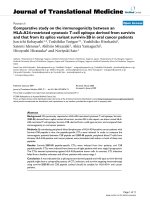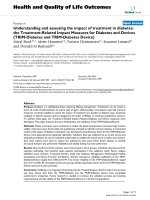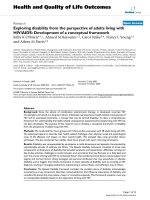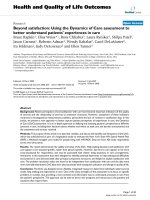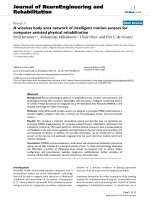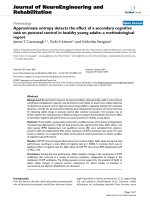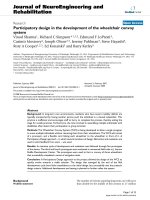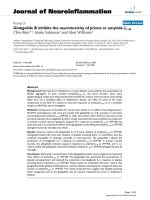Báo cáo hóa học: " A study on the effect of different chemical routes on functionalization of MWCNTs by various groups (-COOH, -SO3H, -PO3H2)" potx
Bạn đang xem bản rút gọn của tài liệu. Xem và tải ngay bản đầy đủ của tài liệu tại đây (1.26 MB, 9 trang )
NANO EXPRESS Open Access
A study on the effect of different chemical routes
on functionalization of MWCNTs by various
groups (-COOH, -SO
3
H, -PO
3
H
2
)
Pawan Kumar
1
, Jin-Soo Park
2*
, Prabhsharan Randhawa
1
, Sandeep Sharma
1
, Mun-Sik Shin
2
and
Satpal Singh Sekhon
1*
Abstract
Pristine multiwall carbon nanotubes [MWCNTs] have been functionalized with various groups (-COOH, -SO
3
H,
-PO
3
H
2
) using different single- and double-step chemical routes. Various chemical treatments were given to
MWCNTs using hydrochloric, nitric, phosphoric, and sulphuric acids, followed by a microwave treatment. The effect
of the various chemical treatments and the dis persion using a surfactant via ultrasonication on the
functionalization of MWCNTs has been studied. The results obtained have been compared with pristine MWCNTs.
Scanning electron microscopy, energy dispersive X-ray [EDX] spectroscopy, and transmission electron microscopy
confirm the dispersion and functionalization of MWCNTs. Their extent of functionalization with -SO
3
H and -PO
3
H
2
groups from the EDX spectra has been observed to be higher for the samples functionalized with a double-step
chemical route and a single-step chemical route, respectively. The I
D
/I
G
ratio calculated from Raman data shows a
maximum defect concentration for the sample functionalized with the single-step chemical treatment using nitric
acid. The dispersion of MWCNTs with the surfactant, Triton X-100, via ultrasonication helps in their unbundling, but
the extent of functionalization mainly depends on the chemical route followed for their treatment. The
functionalized carbon nanotubes can be used in proton conducting membranes for fuel cells.
Keywords: functionalization, carbon nanotubes, dispersion, surfactant
Introduction
Currently, carbon nanotubes [CNTs] are the state-of-
the-art materials actively studied by both experimental-
ists and theoreticians because of their versatile struc-
tural, electronic, mechanical, optical properties [1-3].
The pristine CNTs generally exist in bundled form due
to the presence of strong Van der Waals interactions
between them. In part icular , these intermolecular forces
of attraction are based on the pi [π] bond stacking phe-
nomena between adjacent nanotubes, and there can be
at least hundreds of π stacking sites between two CNTs.
Hence, intermolecular forc es are very strong. CNTs
should be unbundled prior to their use for a ny applica-
tion. Dispersion of nanotubes can be achieved using
various surfactants, polymers, biomolecules, etc. via a
physical or chemical method. In the case of surf actants,
the surfactant groups get adsorbed onto the CNT sur-
face without disturbing the π stacking system of the gra-
phene sheet and result in dispersion. Out of the
different surfactants being used for the dispersion of
CNTs like sodium dodecylbenzenesulfonate [SDS],
dodecyltrimethyl ammonium bromide, Tween 20
(Sigma-Aldrich, St. Louis, MO, USA), Tween 80 (ICI
Americas, Inc., Wilmington, D E, USA), Triton X -100
(Dow Chemical Company, Midland, MI, U SA), etc., the
SDS and Triton X-100 have been reported to result in
the minimum and the maximum dispersions of nano-
tubes, respectively [4]. Triton X-100 is mainly used to
disperse CNTs due to its number of advantages includ-
ing a non-covalent approach for dispersion, and the pre-
sence of a benzene ring in its chemical structure can be
easily removed by washing. The most common approach
is to disperse the CNTs in an aqueous surfactant
* Correspondence: ;
1
Department of Physics, Guru Nanak Dev University, Amritsar, 143005, India
2
Department of Environmental Engineering, College of Engineering,
Sangmyung University, Cheonan, Chungnam Province, 330-720, Republic of
Korea
Full list of author information is available at the end of the article
Kumar et al. Nanoscale Research Letters 2011, 6:583
/>© 2011 Kumar e t al; licensee Springer. This is a n Open Access article distributed under the terms of the Creative Commons Attribution
License ( which permits unrestricted use, distribution, and reproduction in any medium,
provided the original work is properly cited.
solution, which is then subjected to ultrasonication in
order to mechanically break the aggregation and even-
tually yield fully separated CNTs. The surfactant mole-
cules are adsorbed onto the surface of CNTs (as shown
in Scheme 1, see Additional file 1), have repulsion
between them, and hence help to disperse the CNTs [5].
Dispersion of CNTs depends upon a number of factors,
such as the type of CNTs, their geometry, the relative ratio
of CNTs, and the type of surfactant being used. After dis-
persing the nanotubes, it is desirable to functionalize them
with various chemical groups depending upon the applica-
tion for which we want to use them.
Various chemical groups can be attached physically or
chemically to the side walls or end caps o f nanotubes,
without significantly changing their desirable properties
[6]. This process is called functionalization of nanotubes.
A large number of methods are being used for the functio-
nalization of CNTs, which can be broadly divided into the
endohedral and exohedral methods. We have followed the
exohedral mode in which the che mical groups are
attached to the outer wall of the CNTs. Exohedral functio-
nalization can be further subdivided into the covalent and
non-covalent approaches. In the covalent approach, func-
tionalization has been achieved by attaching the functional
group on the side walls, end caps, or defect sites of nano-
tubes with a covalent bond, whereas in the non-covalent
approach, chemi cal groups are attached by the wrapping
of polymers, biomolecules, etc. on nanotubes.
In the present study, MWCNTs have been covalently
functionalized with different chemical groups (-COOH,
-SO
3
H, -PO
3
H
2
) using va rious single- and double-step
chemical routes. The effect of dispersion using Triton
X-100 via ultrasonication, before the functionalization of
CNTs, has also been studied. The defect concentration
has been determined from Raman studies. The extent of
functionalization with different groups has been deter-
mined from the EDX results and chemical routes which
results in the identification of sulfonation and phospho-
nation of higher extents.
Experimental details
Multiwall carbon nanotubes [MWCNTs] (CNT M95,
Carbon Nano-material Technology Co., Ltd., Pohang Si
Nam-gu, Gyeongsangbuk-do, South Korea) with a dia-
meterof5to15nm,alengthof10μm, and a purity >
95% have been used as received in t he present study.
We have functionalized four different samples of
MWCNTs. The details of the se prepared samples and
their codes are given in Table 1, and the methods of
functionalization of each sample MWCNT are given as
follows.
FPCNT01
Forty milligrams of MWCNTs had been taken, a nd 20
mL HNO
3
was added to it. The sample was refluxed for
240 min at 100°C. Furthermore, the s ample was given
multiple washings via centrifugation at 12, 000 rpm for
6min(sixtimes)anddriedovernightinanovenat60°
C. For the second step of functionalization, a 1:1 v/v
ratio of HNO
3
and H
2
SO
4
(15 mL each) was added to
the dried sample. Microwave treatme nt was given for 5
minonanon/offbasis.Afterthis,20mLofHClwas
added slowly to the sample, and it was refluxed for 60
min at an ambient temperature. In order to give the
sample multiple washings, centrifugation was done at
12, 000 rpm for 6 min (six times). The functionalized
sample was dried overnight in an oven at 60°C.
FCNT03
Fifty milligrams of MWCNTs had been taken and dis-
persed with 1.9% Triton X-100 and 200 mL of deionized
[DI] water via ultrasonication for 120 min. After this,
the sample had been given multiple washings through
centrifugation at 7, 000 rpm for 10 min (six times) and
dried overnight in an oven at 60°C. For the functionali-
zation, a 1:1 v/v ratio of HNO
3
and HCl (2 5 mL each)
was added to the dried dispersed sample, and it was
refluxed for 90 min at 80°C and then centrifuged at 12,
000 rpm for 10 min (six times). The functionalized sam-
ple was dried overnight in an oven at 60°C.
DFCNT03
Fifty milligrams of MWCNTs had been taken and dis-
persed with 1% Triton X-100 and 200 mL DI water via
ultrasonication for 60 min. After this, the sample had
been given multiple washings through centrifugation at
Table 1 Sample codes
S. no. Amount of MWCNTs Chemical route
followed
Dispersion before functionalization Functional groups
attached
Sample
code
1 40 mg Double-step functionalization No -COOH
-SO
3
H
FPCNT01
2 50 mg Double-step functionalization Yes -COOH
-SO
3
H
DFCNT03
3 50 mg Single-step functionalization Yes -COOH FCNT03
4 20 mg Single-step functionalization No -COOH
-PO
3
H
2
PhCNT01
Kumar et al. Nanoscale Research Letters 2011, 6:583
/>Page 2 of 9
12, 000 rpm for 6 min (six times) and dried overnight in
an oven at 60°C. Furthermore, a 1:1 v/v ratio of HNO
3
and
HCl (25 mL each) was added to the dried dispersed sam-
ple, and it was refluxed at 80°C for 90 min. The sample
had been given multiple washings via centrifugation at 12,
000 rpm for 6 min (six times) and dried overnight in an
oven at 60°C. For the second step of functionalization, a
1:1 v/v ratio of HNO
3
and H
2
SO
4
(25 mL each) was added
to the dried sample, and microwav e t reatment was given
for5minonanon/offbasis.Afterthis,30mLHClwas
added slowly to the above mixture. The sa mple was then
refluxed for 60 min at an ambient temperature, followed
by centrifugation at 12, 000 rpm for 6 min (six times). The
sample was dried overnight in an oven at 60°C.
PhCNT01
Twenty milligrams of MWCNTs had been taken, and 10
mL of H
3
PO
4
was preheated at 60°C for 20 min and then
added to the CNTs. Furthermore, 10 mL of H NO
3
was
added to the above mixture. It was mixed and refluxed at
130°C for 60 min. In order to give multiple washings, the
sample was centrifuged at 12, 000 rpm for 6 min (six
times) and dried overnight in an oven at 60°C.
Transmission electron microscopy
Transmission electron microscopy [TEM] (Libra 120,
Carl Zeiss AG, Oberkochen, Germany) at an accelera-
tion voltage of 120 kV was used to examine the size and
distribution of the CNT surface of various samples. The
TEM specimens were prepared by placing a few drops
of the sample solution on a lacey carbon grid.
Scanning electron microscopy
Scanning electron microscopy [SEM] micrographs were
obtained with a Hitachi S-4800 field-emission SEM
(Hitachi High-Tech, Minato-ku, Tokyo, Japan) at an
acceleration voltage of 0.5 to 30 kV. Specimens for
high-resolution imaging were coated with Osmium.
Energy dispersive X-ray
The energy dispersive X-ray [EDX] (X-Max 50011,
HORIBA Ltd., Minami-Ku, Kyoto, Japan) spectra were
obtained to determine the elemental information on the
CNT at 16 kV and 15 μA.
Raman spectra
Raman spectroscopy was carried out at room tempera-
ture using a FRA 106/S (BRUKER OPTIK GMBH,
Ettlingen, Germany) Raman spectrometer, with a 1006-
nm Nd-YAG laser and a 4-cm
-1
resolution.
Results and discussion
Pristine CNTs are generally chemically inert and insolu-
ble in many solvents. In order to make them suitable for
various applications, they have to be functionalized with
different groups. The functionalized CNTs are soluble in
various organic solvents. The functionalization of CN Ts
strongly depends upo n the chemical route followed. In
the present study, different chemical routes have been
used for the functionalization of CNTs with the
-COOH, -SO
3
H, and -PO
3
H
2
groups, and their effects
on the functio nalization have been studied. MWCNTs
have been functionalized with the -COOH, -SO
3
H, and
-PO
3
H
2
groups using various chemical routes given in
Scheme 2 (see Additional file 2):
- Single-step process (FCNT03 and PhCNT01)
- Double-step process (FPCNT01 and DFCNT03)
- Without dispersion with surfactant (FPCNT01 and
PhCNT01)
- After dispersion with surfactant (DFCNT03 and
FCNT03).
The photographs of MWCNTs before and after soni-
cation are given in Figure 1. Pristine CNTs are not solu-
ble in water and settle down at the bottom of the flask
as observed in Figure 1 . However, after sonication for
one hour, CNTs are dispersed, and a uniform solution
is obtained as observed in Figure 1. The dispersion of
CNTs after sonication was also studied by S EM. The
SEM micrographs of CNT samples before and after
sonicationaregiveninFigure2.TheSEMmicrograph
of pristine CNTs shows the presence of bundles and
ropes of nanotubes, which have been observed to be dis-
persed after sonication.
The functionalization of MWC NTs with different
groups using single- and double-step chemical routes
has also been studied by SEM, and the micrographs for
different samples are given in Figure 3. The bundles
present in the pristine sample have been also observed
to be dispersed after the functionalization of MWCNTs
by different groups. Samples FPCNT01 and PhCNT01,
which have been functionalized after sonication, show
dispersion which takes place due to sonication as well as
functional izatio n. The extent of dispersion is be tter in
the sample, PhCNT01, which has been functionalized
with the -COOH and -PO
3
H
2
groups. The SEM micro-
graphs also co nfirm the presence of the attached groups
on the outer walls of MWCNTs. The presence of the
different chemical groups (-COOH, -SO
3
H, and
-PO
3
H
2
) on the walls of the MWCNTs and their quanti-
tative amounts have also been studied by EDX. The
EDX plots for the different samples are given in Figure
4, which shows the presence of carbon, oxygen, sulfur,
and phosphorus in the functionalized samples. Since the
as-received MWCNTs used in the present study are
95% pure, some catalytic elements are also present in
small amounts and are detected in the EDX results. The
Kumar et al. Nanoscale Research Letters 2011, 6:583
/>Page 3 of 9
quantitative (weight and atomic percent) amounts of the
different elements (C, O, S, P) present in these samples
have been calculated from the EDX data, and their
values are listed in Table 2. From the EDX data, it has
been observed that out of the two samples, FCNT03
and PhCNT01, which have been functionalized by a sin-
gle-step chemical route, sample PhCNT01 is better
functionalized (phosphorus content 25 wt.%). The SEM
results for this sample (Figure 3) also confirm its better
functionalization. This shows that the use of H
3
PO
4
acid for functionalizing CNTs is the most effective, and
a large number of -PO
3
H
2
groups are attached. For
samples FPCNT01 and DFCNT03, which have been
functionalized with the -COOH and -SO
3
Hgroups
using a double-step chemical route, the EDX data show
that the functionaliz ation with the -SO
3
Hgroupisbet-
ter in sample FPCNT01 than in DFCNT03. The sulfur
content in FPCNT01 and in FPCNT03 is 0.6 and 0.34
wt.%, respectively. This shows that the doubl e-step che-
mical route followed for the functionalization of sample
FPCNT01 is relatively more effec tive for the sulfonation
(-SO
3
H) of MWCNTs, whereas the maximum phospho-
nation (-PO
3
H
2
) has been achieved for sample
PhCNT01 which was functionalized with a single-step
chemical route. It shows that, ultimately, the more
important step for functionalization of MWCNTs is the
chemical route followed for their treatment even though
dispersion assists in the unbundling of CNTs. Functio-
nalization also assists in the dispersion of MWCNTs.
The disper sion and funct ionalizat ion of MWCNTs
with various groups were also confirmed by TEM stu-
dies , and the TEM mi crographs of the different samples
are given in Figure 5. Sample FPCNT01, which has been
functionalized with the -COOH and -SO
3
Hgroups,
shows dispersion. Sample PhCNT01, which has been
functionalized with -PO
3
H
2
groups, shows a larger func-
tionalization which is also supported by the EDX results
(Table 2). The TEM micrographs show that sample
FPCNT01, which shows a relatively higher degree of sul-
fonation (Table 2) , also shows better dispersion as
a
b
Figure 1 Sample photographs before (a) and after (b) ultrasonication (photograph taken after 24 h of dispersion).
Kumar et al. Nanoscale Research Letters 2011, 6:583
/>Page 4 of 9
comp ared with sampl e DFCNT03. Thus, for sulfonation
of CNTs, the chemical route followed for the functiona-
lization of sample FPCNT01 shows better results.
The chemical route followed for the functionalization
of CNTs, as given in Scheme 1, involves the use of
strong acids (HCl, HNO
3
,H
2
SO
4
,andH
3
PO
4
). These
acids have been reported to damage the surface of
CNTs and also create defects which generally act as
potential sites for the attachment of different chemical
groups. The defect concentration in CNTs can be stu-
died by Raman spectroscopy. The Raman spectra of the
different samples have been recorded and are shown in
a
b
Figure 2 SEM micrographs of CNTs before (a) and after (b) dispersion.
Kumar et al. Nanoscale Research Letters 2011, 6:583
/>Page 5 of 9
FPCNT01
PhCNT01
FCNT03
DFCNT03
Figure 3 SEM micrographs of different functionalized samples.
FPCNT01
PhCNT01
FCNT03
DFCNT03
Figure 4 EDX spectra for different samples.
Kumar et al. Nanoscale Research Letters 2011, 6:583
/>Page 6 of 9
Figur e 6. The most intense band near 1, 600 cm
-1
is the
characteristic band (G band) of graphene and is due to
the in-plane vibrations of carbon atoms. The band near
1, 280 cm
-1
is due to the disorder or structural defects
(D band) in the graphene sheet. The ratio of the intensi-
ties of the D and G bands (I
D
/I
G
) is generally taken as a
measure of the defect concentration. This ratio has been
calculated for the different samples from the Raman
data, and the values are listed in Table 3. The ratio is
highest for sample FCNT03, which shows that the che-
mical route followed for the functionalization of this
sample creates a larger number of defects on the surface
of CNTs. Similarly, out of samples FCNT03 and
DFCNT03, this ratio is higher for sample FCNT03
which also shows a higher degree of functionalization as
observedfromEDXresults.Thus, it has been observed
that the chemical route followed for the functionaliza-
tion of CNTs plays an important role and must be opt i-
mized for proper functionalization.
Conclusions
MWCNTs have been functionalized with different
groups using various single- and double-step chemical
routes. The maximum sulfonation (functionalization
with -SO
3
H groups) has been achieved for sample
FPCNT01 which was function alized using a double-step
chemical route, whereas the maximum phosphonation
(functionalization with -P O
3
H
2
groups) has been
Table 2 Concentration of different elements from EDX
data
Element C O P S
Sample (w.%) (at.%) (w.%) (at.%) (w.%) (at.%) (w.%) (at.%)
FPCNT01 82 87 16 14 - - 0.60 0.24
PhCNT01 24 34 50 52 25 13 - -
FCNT03 78 83 18 15 - - - -
DFCNT03 86 89 13 10 - - 0.34 0.13
FPCNT01
PhCNT01
FCNT03
DFCNT03
Figure 5 TEM images for different samples.
Kumar et al. Nanoscale Research Letters 2011, 6:583
/>Page 7 of 9
achieved for sample PhCNT01. The highest defect con-
centration (I
D
/I
G
) has been observed for sample
FCNT03, which has been functionalized with a single-
step process using HNO
3
. The dispersion of CNTs
using a surfactant helps in their unbundling, but the
more important step is the chemical route followed for
their functionalization as observed from EDX results. A
proper choice of the chemical route and the amount o f
acid used can be helpful to control the extent of func-
tionalization with various chemical groups. The
incorporation of CNTs functionalized with the - SO
3
H
and - PO
3
H
2
groups in sulfonated polymers can be used
as high temperature fuel cell membranes.
Additional material
Additional file 1: Scheme 1. Mechanism of dispersion of CNTs [5].
Additional file 2: Scheme 2. Chemical route followed for the
functionalization of different samples.
Acknowledgements
PR thanks CSIR, New Delhi for the award of SRF. This research is supported
in part by the 2011 Basic Research Program of Korea Institute of Energy
Research (KIER) and in part by the New and Renewable Energy of Korea
Institute of Energy Technology Evaluation and Planning (KETEP) grant
funded by the Korean government’s Ministry of Knowledge Economy (no.
2010T100100838).
Author details
1
Department of Physics, Guru Nanak Dev University, Amritsar, 143005, India
2
Department of Environmental Engineering, College of Engineering,
FCNT03
FPCNT01
PhCNT01
DFCNT03
Figure 6 Raman spectra for different samples.
Table 3 Intensities of the G and D bands and intensity
ratio (I
D
/I
G
) calculated from Raman data
Sample G band D band I
D
/I
G
Position of
peak (cm
-1
)
Intensity Position of
peak (cm
-1
)
Intensity
FPCNT01 1602 0.00363 1285 0.00484 1.3333
PhCNT01 1602 0.00359 1293 0.00483 1.3454
FCNT03 1602 0.00304 1289 0.00428 1.40789
DFCNT03 1600 0.00296 1286 0.00383 1.3454
Kumar et al. Nanoscale Research Letters 2011, 6:583
/>Page 8 of 9
Sangmyung University, Cheonan, Chungnam Province, 330-720, Republic of
Korea
Authors’ contributions
PR, PK, and SS prepared the samples. JSS and MSS helped in the
characterization studies. SSS and PR conceived the study and participated in
the study and analysis. All authors contributed equally and also approved
the final manuscript.
Competing interests
The authors declare that they have no competing interests.
Received: 3 August 2011 Accepted: 7 November 2011
Published: 7 November 2011
References
1. Dresselhaus MS, Dresselhaus G, Aouris P, (Eds): Carbon nanotubes: synthesis,
structure, properties and applications New York: Springer; 2001.
2. Iijima S: Helical microtubules of graphitic carbon. Nature 1991, 354:56-58.
3. Dresselhaus MS, Dresselhaus G, Jorio A: Unusual properties and structure
of carbon nanotubes. Ann Rev Mater Res 2004, 34:247-278.
4. Rastogi R, Kaushal R, Tripathi SK, Sharma AL, Kaur I, Bharadwaj LM:
Comparative study of carbon nanotube dispersion using surfactants. J
Colloid Interface Sci 2008, 328:421-428.
5. Datsyuk V, Landois P, Fitremann J, Peigney A, Galibert AM, Soula B,
Flahant E: Double-walled carbon nanotube dispersion via surfactant
substitution. J Mater Chem 2009, 19:2729-2736.
6. Karousis N, Tagmatarchis N: Current progress on the chemical
modification of carbon nanotubes. Chem Rev 2010, 110:53665397.
doi:10.1186/1556-276X-6-583
Cite this article as: Kumar et al.: A study on the effect of different
chemical routes on functionalization of MWCNTs by various groups
(-COOH, -SO
3
H, -PO
3
H
2
). Nanoscale Research Letters 2011 6:583.
Submit your manuscript to a
journal and benefi t from:
7 Convenient online submission
7 Rigorous peer review
7 Immediate publication on acceptance
7 Open access: articles freely available online
7 High visibility within the fi eld
7 Retaining the copyright to your article
Submit your next manuscript at 7 springeropen.com
Kumar et al. Nanoscale Research Letters 2011, 6:583
/>Page 9 of 9
